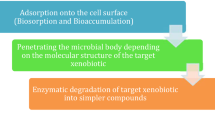Abstract
In the present studies potential of microorganisms isolated from the cotton fields was explored for the bioremediation of fipronil contaminated soils. The cultures of microbes were grown in Luria broth as shake culture maintained at 28°C. After that Dorn’s broth enrichment culture supplemented with fipronil was used and isolated two bacterial cultures viz. Paracoccus sp. and Gamma Proteobacteria. The performance of both bacteria was evaluated for degradation of fipronil in soil. Paracoccus sp. was found better than the Gamma Proteobacteria as far as degradation of fipronil in soil is concerned. The samples of soil were extracted and cleaned up by following a standardized methodology. Fipronil was quantified by gas liquid chromatography and confirmed by gas chromatography mass spectrometer. The limit of quantification of fipronil was worked out to be 10 μg kg−1. By using this methodology, the mean recoveries of fipronil in different types of soil were found to be more than 85%. The residues of fipronil were found to persist only up to 10 days in soils fortified with fipronil @ 20 μg kg−1 and amended with Paracoccus sp. while in the soils fortified @ 80 μg kg−1 fipronil, residues persisted up to 20, 30 and 30 days in loamy sand, sandy loam and clay loam, respectively. Therefore, the use of Paracoccus sp. can further be explored for the bioremediation of fipronil contaminated soils.

Similar content being viewed by others
References
Aajoud A, Ravanel P, Tissut M (2003) Fipronil metabolism and dissipation in a simplified aquatic ecosystem. J Agric Food Chem 51:1347–1352
Anonymous (2000) http://www.Google.co.in/fipronilpesticidesnews 48: 20
Anonymous (2004) Fipronil. Pesticide action network UK, Eurolink Ctr., 49 Effra Road, London SW2 1BZ. 18 May 2004. http://www.panuk.org/pestnews/activities/fipronil.htm
Chanton PF, Ravanel P, Tissut M, Meyran JC (2001) Toxicity and bioaccumulation of fripronil in the nontarget arthropodan fauna associated with subalpine mosquito breeding. Ecotoxic Envir Saf 52:8–12
Cole LM, Nicholson RA, Casida JE (1993) Action of phenyl pyrazole insecticide at the GABA-gated chloride channel. Pestic Biochem Physiol 46:47–54
Connelly P (2001) Enviornmental fate of fipronil. Environment monitoring branch, Department of pesticide regulation, California environmental protection agency, (www.pw.ucr.edu/textfiles/fipronil.pdf)
Dange M (1994) Acute Oral LD50 in rats. Unpublished report no. SA 93074. Submitted to the World Health Organization by Rhone-Poulenc, Inc.: Research Triangle Park, NC
Fenet H, Beltran E, Gadji B, Cooper JF, Coste CM (2001) Fate of a phenylpyrazole in vegetation and soil under tropical field conditions. J Agric Food Chem 49:1293–1297
Goswami S, Vig K, Singh DK (2009) Biodegradation of α and β endosulfan by Aspergillus sydoni. Chemosphere 75(7):883–888
Kumar M, Lakshmi CV, Khanna S (2008) Biodegradation and bioremediation of endosulfan contaminated soil. Bioresour Technol 99(8):3116–3122
Singh DK (2008) Biodegradation and bioremediation of pesticide in soil: concept, method and recent developments. Indian J Microbiol 48:35–40
Tingle CC, Rother JA, Dewhust CF, Lauer S, King WJ (2003) Fipronil: environmental fate, ecotoxicology, and human health concerns. Rev Envir Contam Toxic 176:1–66
Tomlin CDS (2000) The pesticide manual The British Crop Protection Council. Surrey, U.K. pp 413–415
Ware GW (2000) An introduction to insecticides. The pesticide book. Thomson Publications, Fresno, CA, p 69
Weisburg WG, Barns SM, Pelletier DA, Lane DJ (1991) 16S ribosomal DNA amplification for phylogenetic study. J Bact 173(2):697–703
Ying GG, Kookana RS (2002) Laboratory and field studies on the degradation of fipronil in a soil. Aust J Soil Res 40:1095–1102
Acknowledgments
The authors are grateful to the Head, Department of Entomology, Punjab Agricultural University Ludhiana for providing research facilities to carry out these studies.
Author information
Authors and Affiliations
Corresponding author
Electronic supplementary material
Below is the link to the electronic supplementary material.
Rights and permissions
About this article
Cite this article
Kumar, R., Singh, B. & Gupta, V.K. Biodegradation of Fipronil by Paracoccus sp. in Different Types of Soil. Bull Environ Contam Toxicol 88, 781–787 (2012). https://doi.org/10.1007/s00128-012-0578-y
Received:
Accepted:
Published:
Issue Date:
DOI: https://doi.org/10.1007/s00128-012-0578-y




